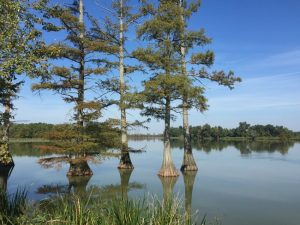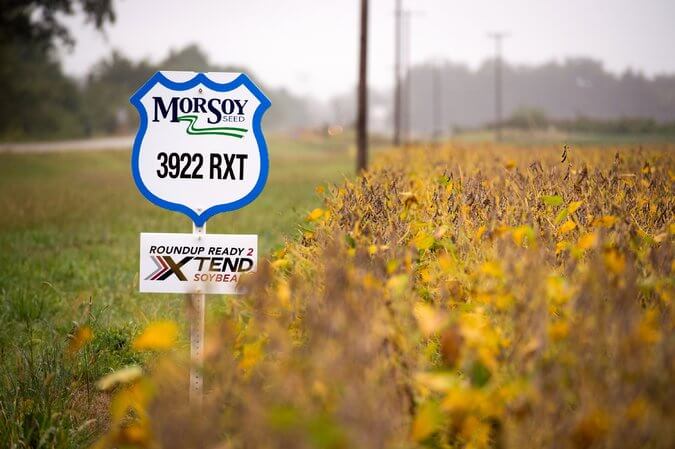In just a couple more months, Arkansas farmers will be planting soybeans in their fields again. So, that means another contentious round of meetings and hearings so the Arkansas Plant Board can decide how and when soybean farmers will be able to spray dicamba on their fields.
The dicamba drift disaster of the last couple of years, covered extensively here on Hygeia and via our Dicamba Watch herbicide timeline, has left millions of acres of damaged by drifting herbicide. Specialty crops like tomatoes, home gardens, non-herbicide resistant soybeans, and some tree species were particularly vulnerable.
Last year, the Arkansas Plant Board allowed only a brief window for dicamba application, banning its use after April 15, 2018 following a disastrous 2017 season where the state had the most dicamba-related damage investigations in the country – 986, according to data from a Weed Science Society of America report. An estimated 900,000 acres were affected, although extension weed science experts in multiple states expect many impacted fields were never reported.
For the 2019 season, the plant board has put forth a recommendation that extends the spray deadline about a month to May 20th. Plus, application between April 16 and May 20 would also require an extended, “one-mile buffer zone around research stations, organic crops, specialty crops, non-tolerant dicamba crops and other sensitive crops and will also include a restriction on mixing glyphosate with dicamba” (AMP News, 2019).
The proposal is now out for comment, with a public hearing scheduled for later this month. Arkansas, Money, and Politics News reports that as of late January 2019, the Arkansas Agriculture Department has received 375 comments from the online submission process alone. Mail and email comments have not been counted yet (AMP News, 2019).
One of the voices chiming in is a familiar one. Steve Smith is the Chairman of the Save Our Crops Coalition and R&D Director of Red Gold, the largest tomato processor in the Midwest. Steve has shared his thoughts on the dicamba debacle several times before, both as scientist engaged on a near-daily basis during the growing season with weed management system challenges and as a Midwestern landowner whose property has been adversely impacted by drifting dicamba. With Steve’s permission, Hygeia Analytics is pleased to share his comments to the Arkansas Plant Board on their proposed dicamba rule.
Smith credits the state of Arkansas for leading “the entire nation in researching, recognizing, understanding and reacting to the threat that this particular compound brings to all of agriculture.” But, he cautions, the proposed new cut-off date of May 21st “will subject many acres of sensitive crops, pollinator habitats and rural landscapes to continued injury” (Smith, 2019).
While the one-mile buffer is a “definite step towards safety of sensitive crops,” Smith questions whether this requirement will be adhered to. Plus, he cautions that atmospheric loading will likely occur if large acreages are treated, which could affect “rural communities and pollinator habitats” (Smith, 2019).

In a guest editorial in the Northwest Arkansas Democrat-Gazette, Dan Scheiman, the bird conservation director for Audubon Arkansas, echoes some of these sentiments. Scheiman is also concerned about increased volatility and atmospheric loading with the higher temperatures found later in the spring, and shares a stark observation by a local scientist:
“University of Arkansas weed scientist Dr. Jason Norsworthy told the state Plant Board in December that if every soybean and cotton farmer in Mississippi County grows Monsanto’s dicamba-resistant variety, no other type of sensitive crops will be able to grow anywhere in that county because there will be so much dicamba in the air. That is bad news for farmers growing tomatoes, peanuts, and sweet potatoes, and ruinous for any organic farming operations” (Scheiman, 2019).
But Scheiman also stresses the potential “unintended consequences” and negative impacts to trees, gardens, and pollinators, as well as wildlife areas recognized by Audubon as “Important Bird Areas.” He states that “the science is clear that dicamba’s volatility makes it a serious threat for agriculture and the environment when used in warm weather conditions” and closes with a plea for readers to submit comments.
The public meeting on February 20th will be lively. It seems that public pressure is continuing to mount as more people start suffering the side-effects of dicamba use. We shall see if regulators respond in kind.
Sources:
AMP News, “Dicamba Proves to be a Hot Topic in Arkansas,” Date published: January 22, 2019, Date accessed: February 6, 2019.
Steve Smith, “Comments to Arkansas Plant Board, Proposed Dicamba Rule,” Submitted January 31, 2019.
Dan Scheiman, “Opinion: Birds, crops at risk, Dicamba rule change dangerous,” Northwest Arkansas Democrat-Gazette, Date published: January 31, 2019, Date accessed: February 6, 2019.

